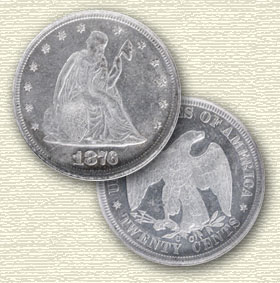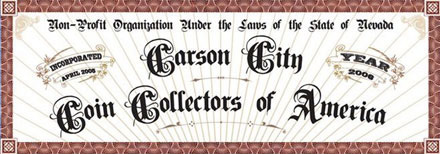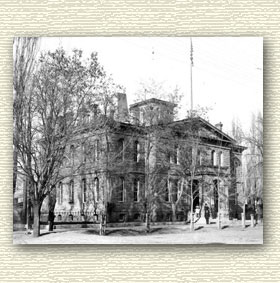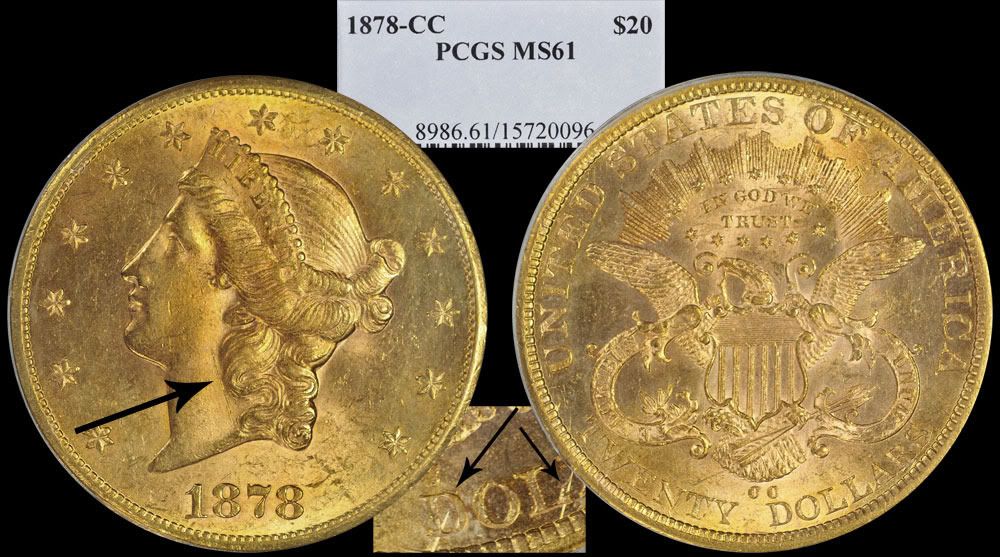- Posts: 176
- Thank you received: 0
1878-CC $20 GOLD CC COIN OF THE WEEK – 11-30-09
15 years 11 months ago - 15 years 11 months ago #590
by randysc
1878-CC $20 GOLD CC COIN OF THE WEEK – 11-30-09 was created by randysc
1878-CC $20 Gold Piece
In 1878, the mines of Virginia City were still in full production, although in about another two years the peak will have passed and the decline would begin. Two events of 1878 would have direct ties to Virginia City and the Comstock Lode, one would be the passing of William S. O'Brien, one of the "Big Four" who along with John Mackay, James Fair and James Flood, were the richest men in control of the richest mines on the Lode. O'Brien was 52 and worth between 12 to 15 million dollars when he died.
Another event was the completion of the Sutro Tunnel, Adolph Sutro's answer to mine drainage and ore transportation. After about nine years of digging, starting a bit north of Dayton Nevada, the tunnel punch into the lode on July 8, 1878 at the 1600 foot level. The only problem was, by then most of the mines were deeper that 1600 feet therefore the tunnel didn't help much with the drainage and with the V & T Railroad built in 1869, ore transportation had been dealt with also. But Sutro still came out on the deal, selling his share of the tunnel for about $1,000,000, moving to San Francisco, prospering there and eventually becoming that city's mayor.
But the mines were still in good production in 1878, you wouldn't realize that by the mintage totals of the 1878 Carson City double eagle, the total being 13,180. Up to 1878, this total is the lowest mintage number of CC double eagles since the 1870 (the 1879 would be even less at 10,708). the Carson City Mint usually had the lowest mintage totals of the three major producers of double eagles (Philadelphia and San Francisco being the other two. New Orleans made double eagles only in 1879 during the CC mint's run) but 1878 saw a signifagent drop of the CC double eagle production. Why, with the main suppliers being just 15 miles away, would gold delivery fall below $1,000,000 for the first time since the the Carson City Mint opened in 1870? in contrast, the San Francisco Mint saw its largest production of the decade in 1878 with a mintage total of 1,739,000 double eagles in a decade where yearly totals were well over a million.
One reason and possibly the only reason is that the mine and mill owners of the Comstock were always contemptuous of the Carson City mint. They didn't care for Abe Curry to start with and that carried on to his mint and never ceased. They would rather send their bullion to San Francisco, hundreds of miles away than to deal with the CC mint. To bad for mint employees but good for the collector as it kept minting numbers low therefore making CC coins more sought after collectables.
Of the total 13,180 1878-CC double eagles produced, about three percent survive or approximately 390-450 in all grades, and less that a dozen of those are in uncirculated grades. Very rare in uncirculated grades and very difficult to find in all grades at coin shows. I almost bought one at a show in San Jose, Calif. about six years ago, certified by PCGS VF-30 priced at $1700. I opted out, buying instead an AU-53 1890-CC double eagle for $1350. I kind of wish I'd have gone for the 1878 as it is the fourth in overall rarity of the ninteen CC double eagles, tied with the 1879. Approximately 80-90 are estamated in Very Fine grades with the rest of the survuval numbers (less the dozen in Unc.) to be in EF to AU grades.
Strikes are usually found to be sharp, with hair detail good and strong, strands well detailed and seperated. The word "Liberty" in the crown can be found a little softly struck.
The 1878-CC twenty can be found with extensive abraded surfaces but not so detracting as with earlier examples of CC double eagles of the 70's. Luster is above average, frosty, slightly grainy texture with some semi-prooflike even prooflike examples.
1878-CC double eagles prices in grades are estimated as follows: VG-$1560, F- $1690, VF- $2450, EF- $4690, AU- $9190, AU 55- $13,980, MS 60- $30,550.
I currently do not own an 1878-CC double eagle, therefore have no pictures for all of you, so I put out a request to anyone who does.
In 1878, the mines of Virginia City were still in full production, although in about another two years the peak will have passed and the decline would begin. Two events of 1878 would have direct ties to Virginia City and the Comstock Lode, one would be the passing of William S. O'Brien, one of the "Big Four" who along with John Mackay, James Fair and James Flood, were the richest men in control of the richest mines on the Lode. O'Brien was 52 and worth between 12 to 15 million dollars when he died.
Another event was the completion of the Sutro Tunnel, Adolph Sutro's answer to mine drainage and ore transportation. After about nine years of digging, starting a bit north of Dayton Nevada, the tunnel punch into the lode on July 8, 1878 at the 1600 foot level. The only problem was, by then most of the mines were deeper that 1600 feet therefore the tunnel didn't help much with the drainage and with the V & T Railroad built in 1869, ore transportation had been dealt with also. But Sutro still came out on the deal, selling his share of the tunnel for about $1,000,000, moving to San Francisco, prospering there and eventually becoming that city's mayor.
But the mines were still in good production in 1878, you wouldn't realize that by the mintage totals of the 1878 Carson City double eagle, the total being 13,180. Up to 1878, this total is the lowest mintage number of CC double eagles since the 1870 (the 1879 would be even less at 10,708). the Carson City Mint usually had the lowest mintage totals of the three major producers of double eagles (Philadelphia and San Francisco being the other two. New Orleans made double eagles only in 1879 during the CC mint's run) but 1878 saw a signifagent drop of the CC double eagle production. Why, with the main suppliers being just 15 miles away, would gold delivery fall below $1,000,000 for the first time since the the Carson City Mint opened in 1870? in contrast, the San Francisco Mint saw its largest production of the decade in 1878 with a mintage total of 1,739,000 double eagles in a decade where yearly totals were well over a million.
One reason and possibly the only reason is that the mine and mill owners of the Comstock were always contemptuous of the Carson City mint. They didn't care for Abe Curry to start with and that carried on to his mint and never ceased. They would rather send their bullion to San Francisco, hundreds of miles away than to deal with the CC mint. To bad for mint employees but good for the collector as it kept minting numbers low therefore making CC coins more sought after collectables.
Of the total 13,180 1878-CC double eagles produced, about three percent survive or approximately 390-450 in all grades, and less that a dozen of those are in uncirculated grades. Very rare in uncirculated grades and very difficult to find in all grades at coin shows. I almost bought one at a show in San Jose, Calif. about six years ago, certified by PCGS VF-30 priced at $1700. I opted out, buying instead an AU-53 1890-CC double eagle for $1350. I kind of wish I'd have gone for the 1878 as it is the fourth in overall rarity of the ninteen CC double eagles, tied with the 1879. Approximately 80-90 are estamated in Very Fine grades with the rest of the survuval numbers (less the dozen in Unc.) to be in EF to AU grades.
Strikes are usually found to be sharp, with hair detail good and strong, strands well detailed and seperated. The word "Liberty" in the crown can be found a little softly struck.
The 1878-CC twenty can be found with extensive abraded surfaces but not so detracting as with earlier examples of CC double eagles of the 70's. Luster is above average, frosty, slightly grainy texture with some semi-prooflike even prooflike examples.
1878-CC double eagles prices in grades are estimated as follows: VG-$1560, F- $1690, VF- $2450, EF- $4690, AU- $9190, AU 55- $13,980, MS 60- $30,550.
I currently do not own an 1878-CC double eagle, therefore have no pictures for all of you, so I put out a request to anyone who does.
Last edit: 15 years 11 months ago by Carsonite.
Please Log in to join the conversation.
15 years 11 months ago #594
by LITAS
Replied by LITAS on topic Re:1878-CC $20 GOLD CC COIN OF THE WEEK – 11-30-09
According to most books describing this coin, two varieties exist.
Variety 1-A shows a raised nearly vertical die scratch on the obverse
on Miss Liberty's neck to the left of the lower hair curls.
Variety 2-B does not have the vertical die scratch.
Can't help you with the image of this coin, I have not found one for
my collection, yet.
John Armonas
Variety 1-A shows a raised nearly vertical die scratch on the obverse
on Miss Liberty's neck to the left of the lower hair curls.
Variety 2-B does not have the vertical die scratch.
Can't help you with the image of this coin, I have not found one for
my collection, yet.
John Armonas
Please Log in to join the conversation.
15 years 11 months ago #595
by randysc
Replied by randysc on topic Re:1878-CC $20 GOLD CC COIN OF THE WEEK – 11-30-09
Thank you for making note of those two varieties, John. I do remember reading about those in Douglas Winter's "Gold Coins of the Carson City Mint" (a really good book), but had a brain lock and failed to mention them. I'm glad someone did, but then, hey, that's what the discussion board is all about, right? Thanks again.
-Randy-
-Randy-
Please Log in to join the conversation.
15 years 11 months ago - 15 years 11 months ago #599
by Carsonite
C4OA Lifer!
Replied by Carsonite on topic Re:1878-CC $20 GOLD CC COIN OF THE WEEK – 11-30-09
Good job Randy. You definitely picked one of the rarest dates in the "CC" gold coin series.
Below is an image of what I believe is one of the finest known specimens of an 1878-CC double eagle. It is the 1-A variety. I have added arrows to show the raised diagonal line on Ms. Liberty's neck and two of the more visible raised die scratches in the word DOLLAR on the reverse.
The long diagonal line on the neck is similar to the raised lines on Ms. Liberty's neck on 1884-CC $10 gold pieces and the ones across Ms. Liberty's lap on 1878-CC quarters. These lines on all three of these coins are more extreme than what we usually see on coins with heavy die polish or ones that have die scratches. We call the 1878-CC quarter with these lines the "semi-canceled die" variety. I suppose we could make a case to use this designation for the 1884-CC eagle and the 1878-CC double eagle as well.
Rusty
Below is an image of what I believe is one of the finest known specimens of an 1878-CC double eagle. It is the 1-A variety. I have added arrows to show the raised diagonal line on Ms. Liberty's neck and two of the more visible raised die scratches in the word DOLLAR on the reverse.
The long diagonal line on the neck is similar to the raised lines on Ms. Liberty's neck on 1884-CC $10 gold pieces and the ones across Ms. Liberty's lap on 1878-CC quarters. These lines on all three of these coins are more extreme than what we usually see on coins with heavy die polish or ones that have die scratches. We call the 1878-CC quarter with these lines the "semi-canceled die" variety. I suppose we could make a case to use this designation for the 1884-CC eagle and the 1878-CC double eagle as well.
Rusty
C4OA Lifer!
Last edit: 15 years 11 months ago by Carsonite.
Please Log in to join the conversation.
15 years 11 months ago - 15 years 11 months ago #605
by Belayoff
C4OA Lifer!
Replied by Belayoff on topic Re:1878-CC $20 GOLD CC COIN OF THE WEEK – 11-30-09
Randy,
What an interesting coin and year in CC history 1878 was. I was particular interested in your comment about the bullion and mine owners not liking Abe Curry, thus not providing much raw metal for the CC mint. I would defer the question about Abe Curry's dislike in the mining industry to Rusty Goe.
My opinion, for what it''s worth, is that the real underlying problem for the lack of production at the Carson City mint was due to the on going political war between Nevada's politicians and John Sherman, the Secretary of the Treasury and his croney, Henry Linderman, the Director of the Mint. Sherman, in particular, blatantly used his office to "punish" Nevada's political leaders (Jones especially) for not siding with his party on several major political issues as well as not supporting Sherman's choice of certain presidential candidates. He did this by undermining the opertions (pun intended) of the Carson City mint. For years on end, he was able to keep the CC mint from receiving the proper funding for full operations...especially with regard to silver purchases. During 1879, for instance, nearly half of the Carson City mint's employees were laid off due to lack of work!
In 1878, Abe Curry had long been gone from the sooty halls of the Carson City mint. James Crawford was the Superintendant (the 4th) from 1874 to 1885. Crawford was almost universally liked in the region. Without his efforts, the mint probably would have crumbled under John Sherman's vengeful attacks many years earlier.
Great posting Randy...thought provoking too. By the way, I found the below image "reportedly" of an 1878 CC $20 PCGS MS 62.
Belay Off
What an interesting coin and year in CC history 1878 was. I was particular interested in your comment about the bullion and mine owners not liking Abe Curry, thus not providing much raw metal for the CC mint. I would defer the question about Abe Curry's dislike in the mining industry to Rusty Goe.
My opinion, for what it''s worth, is that the real underlying problem for the lack of production at the Carson City mint was due to the on going political war between Nevada's politicians and John Sherman, the Secretary of the Treasury and his croney, Henry Linderman, the Director of the Mint. Sherman, in particular, blatantly used his office to "punish" Nevada's political leaders (Jones especially) for not siding with his party on several major political issues as well as not supporting Sherman's choice of certain presidential candidates. He did this by undermining the opertions (pun intended) of the Carson City mint. For years on end, he was able to keep the CC mint from receiving the proper funding for full operations...especially with regard to silver purchases. During 1879, for instance, nearly half of the Carson City mint's employees were laid off due to lack of work!
In 1878, Abe Curry had long been gone from the sooty halls of the Carson City mint. James Crawford was the Superintendant (the 4th) from 1874 to 1885. Crawford was almost universally liked in the region. Without his efforts, the mint probably would have crumbled under John Sherman's vengeful attacks many years earlier.
Great posting Randy...thought provoking too. By the way, I found the below image "reportedly" of an 1878 CC $20 PCGS MS 62.
Belay Off
C4OA Lifer!
Last edit: 15 years 11 months ago by Belayoff. Reason: spelling correction
Please Log in to join the conversation.
Time to create page: 0.213 seconds




